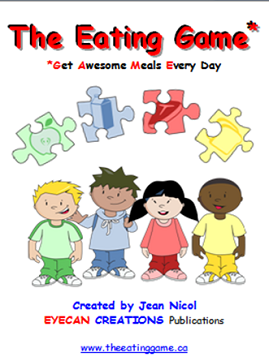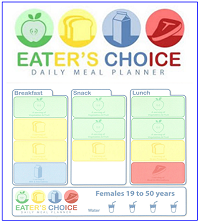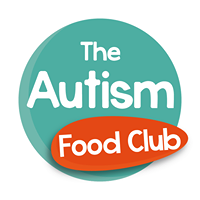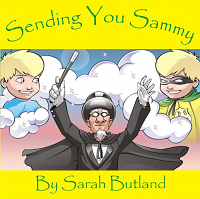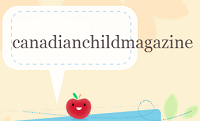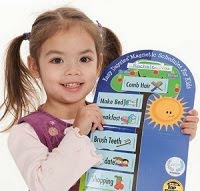We are offering a special GIFT to the first 10 people who qualify and reply.
We will send you a set of NEW Eating Game food pictures that are photos of foods.
This offer is for families using The Eating Game who send us their story and photo with The Eating Game.
Contact us at jean@theeatinggame.ca for more info about this gift.
Wednesday, November 26, 2014
Thursday, October 2, 2014
DO YOU HAVE THIS "GAME" AT YOUR HOUSE?
This program was developed for an autistic child who named it a "GAME" because it was fun! As a parent, caregiver or teacher, I am sure you have observed how attentive children are when playing games that are fun. Further observation would confirm how much children learn when playing games.
This "game is no exception. In fact, children like it to be part of their daily routine! They have fun using lots of colorful visual supports - no reading or writing required and no verbal response required either. The focus is on making food choices from the healthy food pictures you present. Your child will plan their meals and snacks for the day that later they will look forward to eating ~ it was their choice remember! They are learning how to make healthy food choices, with your support of course as you are the purchaser right.
The Eating Game is changing lives ~ kids having fun planning and eating healthy meals and snacks, being in control of the food choices using a structured, highly visual system that creates a predictable eating environment. Parents like the results and there are "no more mealtime battles"!
Invented in Nova Scotia, Canada for a child with autism but it is being used by many who are not on the spectrum around the globe.
Imagine the benefits of this "game" for your child and family. What do you think would be the greatest benefit for you?
This "game is no exception. In fact, children like it to be part of their daily routine! They have fun using lots of colorful visual supports - no reading or writing required and no verbal response required either. The focus is on making food choices from the healthy food pictures you present. Your child will plan their meals and snacks for the day that later they will look forward to eating ~ it was their choice remember! They are learning how to make healthy food choices, with your support of course as you are the purchaser right.
The Eating Game is changing lives ~ kids having fun planning and eating healthy meals and snacks, being in control of the food choices using a structured, highly visual system that creates a predictable eating environment. Parents like the results and there are "no more mealtime battles"!
Invented in Nova Scotia, Canada for a child with autism but it is being used by many who are not on the spectrum around the globe.
Imagine the benefits of this "game" for your child and family. What do you think would be the greatest benefit for you?
Wednesday, October 1, 2014
AN APPETITE SOLUTIONS ADVENTURE
Hello, my name is Michelle Buff and I am a Food
Consultant with Appetite Solutions specializing in children who have limited
appetites. I help parents by teaching them creative ways to get their child to
experience new foods; which in turn helps create a healthier diet.
I am excited to be a part of The Eating Game Advocate newsletter giveaway for the month of October.
I will be giving away a coupon for 70% off my 1-hour phone consultation
fee of $100.00. This means if you are
the winner then you receive my 1-hour phone consultation for the reduced rate
of just $30.00! Please visit me at http://michellefbuff.wix.com/appetitesolutions
This journey of appetite solutions is not a one time one size fits
all gig. If you are beginning your journey then please remember,
"Nothing done well is done once." It takes many failures to
succeed in your child's appetite solutions. There is no magic wand,
potion or a secret treatment.
Each child is different in their way of processing and objectively going through with a plan of action that involves them undertaking such a whole new way of thinking. Something new is not allowed in their routine and if it is then it needs to be scrutinized and broken down for entry so to speak. You know what? That's perfectly OK!
I mean do we expect our own child/children to except something new in their lives when we ourselves are basically the same way? The quick answer is "yes." But if we slow down and not only recognize but except this way of thinking then we can begin that journey you have been talking about with experiencing a new food.
Let me break it down for you in a manner that which you will understand. Not only is your child a literal thinker but he/she also has a brain that is programmed to think a certain way. It is your job to re-program that way of thinking. Begin with simple steps so the both of you are comfortable and see success.
Simple steps
1. Expose the child to the new food in a verbal sense.
2. Keep a food journal
3. Learn about sensory input and output
4. Expose the child to the new food in a sensory friendly and safe
environment
Remember this.....Nothing done well is done once.
I wish you well in your adventures.
To sign up for The Eating Game Advocate, a free monthly e-newsletter and your chance to win at this and all our monthly draws go to http://theeatinggame.ca/
Tuesday, September 16, 2014
THE AUTISM FOOD CLUB
The Autism Food
Club provides the practical implementation of dietary intervention. The
organisation aims to turn scientific research around food and diet into tasty
plates of food for the whole family with a specific focus on the autism
spectrum & related developmental conditions. Although targeted at the
autism spectrum, anybody will benefit from these fantastic recipe ideas and
simple scientific explanations.
Why?
Various
lines of evidence have suggested that the use of a gluten- and casein-free
(GFCF) diet may improve some of the more life disrupting aspects of autism
spectrum disorders (ASDs) at least for some. Coupled to an increasing volume of
recent research reports highlighting some of the potential mechanisms
accounting for a dietary effect, the requirement to translate research findings
from ‘bench to kitchen’ has never been more important. The Autism Food Club (www.theautismfoodclub.com) bridges that gap.
Some of the most
recent reviews of the evidence surrounding the use of the GFCF diet for autism1
whilst not wholly confirmatory, highlight how for some on the autism spectrum,
dietary intervention may be an important addition to other educational and
behavioural interventions. Positive changes to areas of attention and
hyperactivity and communication represent some of the more commonly reported
observations
How?
A
few years back, a fortunate moment led to the meeting of a dietitian, a chef
and an autism researcher. Our ideas are simple: translate the science around
dietary intervention for autism into something readable for everyone and offer
a range of tasty, balanced and easy to make recipes which are gluten- and
casein-free.
Where?
Find us on our
website www.theautismfoodclub.com or come and interact with
us on our Facebook ( https://www.facebook.com/theautismfoodclub ) and Twitter
( https://twitter.com/AutismFoodClub ) pages. Routledge’s have also published our book “Autism:
Exploring a gluten and casein free diet: a practical guide for families and
professionals” (http://www.amazon.com/gp/product/0415727634) which is full of recipes,
background of the science and then an in-depth look at the science and steps to
undertake a gluten- and casein-free diet.
All the
best
The Autism Food
Club team Elouise, Mark and Paul
1.
Whiteley P. et al. Gluten- and casein-free dietary
intervention for autism spectrum conditions. Front Hum Neurosci. 2012; 6: 344.
Labels:
autism,
dietary intervention,
gfcf diet,
The Autism Food Club
Wednesday, September 3, 2014
THE EATING GAME ADVOCATE
MONTHLY GIVEAWAYS
Every month since January 2014 The Eating Game Advocate, our free monthly newsletter, has had a draw for a different giveaway.
January the Giveaway was a Success Box
In February the Giveaway was a set of Video Modelling DVDs
In March Mari Nosal gave away a set of her autism publications
In April Easy Daysies gave away 2 Gift Certificates
In May the Giveaway was discount gift certificates for subscription boxes
In June The Kitchen Classroom gaveaway 2 cookbooks
In July EYECAN CREATIONS Publications gave away an Eating Game
In August we gave away an autographed copy of Sending You Sammy
This month we will giveaway a publication from The Autism Food Club
With these monthly Giveaways we are hoping to increase the number of subscribers to the Eating Game Advocate, a free monthly newsletter delivered to your email address. It is easy to sign up to be a subscriber at https://www.facebook.com/TheEatingGame/app_100265896690345 on facebook or on our website at http://www.theeatinggame.ca.
The newsletter includes information about eating disorders and challenges, ideas to improve your child's diet, info about The Eating Game, recipes and fun food ideas, resources, book reviews and more.
On this blogs page to the right you will find links to websites for all our past giveaway sponsors. Please consider being a blog follower/member.
If you have any ideas/suggestions for future monthly giveaways or newsletter topics please leave a comment.
Tuesday, August 12, 2014
BANANABOY AND THE EATING GAME
BananaBoy is a superhero created to battle the rising
statistics of obesity in Canada and along the way has met some other
superheros, real ones.
Teaming up with Jean Nicol and The Eating Game was a great
decision for both of us. BananaBoy's crusade to teach kids the importance of
eating healthy foods aligns with The Eating Game's focus on balance and
moderation. Together we are making a difference in our province of Nova Scotia
and beyond.
A food revolution is happening everywhere and people are
noticing. Different people are using their talents and passions to make a
difference in many communities which is amazing to see. This month, in
partnership with The Eating Game, I am giving away a signed copy of Sending You
Sammy to one lucky newsletter subscriber.
You'll enjoy telling your kids about BananaBoy and his
friends and love their excitement for choosing healthier foods from The Eating
Game menu for every meal.
Notice a difference when you encourage healthy choices.
Thanks for reading and signing up!
Sarah Butland
Thursday, July 3, 2014
JULY 2014 GIVEAWAY
This month the Giveaway will be an Eating Game. This will be the original Eating Game, ready to use and presented in a 3 ring binder including 5 planning charts and over 200 food pictures.
You will also receive a bonus offer of up to 63 additional food pics of your choice and a Skype session with Jean Nicol, the inventor, to help you with getting started! This bonus will be available to the winner who has read this blog posting and contacts us at jean@theeatinggame.ca for further instructions!
To be in the running for a giveaway you must be a subscriber to The Eating Game Advocate, a free monthly newsletter. It is easy to subscribe at http://www.facebook.com/TheEatingGame/app_1002658960345 or
You will be entered for the giveaway every month until December 2014. Don't delay, sign up today!
Tuesday, July 1, 2014
HOW IT CAN WORK FOR YOU
THE EATING GAME
These photos with description, explain the components of The Eating Game and how it works. It is presented in a 3 ring binder with a copy of Canada's Food Guide, very similar to guide recommendations in other countries.In creating The Eating Game I drew on my education (degree in Nutrition and Education, specializing in Special Education) and my 37 years of work experience as a Special Education Teacher, SchoolBoard Autism Consultant and Early interventionist. For more info and to order your copy go to www.theeatinggame.ca Click on each photo for further explanation. Feel free to ask questions. Modifications can be made too.
 I invented The Eating Game for a 6 year old friend, named Ethan, who is autistic. At the time he preferred to always eat hot dogs and rice; oh and he liked pizza too! So I set out to create something to help him to continue to be in control of his food choices but to expand them to have a more varied, healthier diet. I knew it would have to be very visual and offer structure and routine to make mealtime very predictable. When I was finished my creation I knew, from experience and my knowledge of autism, that I had created something that could help many more children who have restricted diets. And so it evolved ~ The Eating Game ~ it worked for Ethan and is working for many others (testimonialshttp://on.fb.me/bpwxvA ) Even after several years of using The Eating Game every day, Ethan would still choose to use it to plan his meals – he liked being in control of the food choices and he liked the predictable mealtime environment it created for him. I would encourage you to check it out. I always hope it will help another child.
I invented The Eating Game for a 6 year old friend, named Ethan, who is autistic. At the time he preferred to always eat hot dogs and rice; oh and he liked pizza too! So I set out to create something to help him to continue to be in control of his food choices but to expand them to have a more varied, healthier diet. I knew it would have to be very visual and offer structure and routine to make mealtime very predictable. When I was finished my creation I knew, from experience and my knowledge of autism, that I had created something that could help many more children who have restricted diets. And so it evolved ~ The Eating Game ~ it worked for Ethan and is working for many others (testimonialshttp://on.fb.me/bpwxvA ) Even after several years of using The Eating Game every day, Ethan would still choose to use it to plan his meals – he liked being in control of the food choices and he liked the predictable mealtime environment it created for him. I would encourage you to check it out. I always hope it will help another child.
The United States granted my Patent # 8,333,593 B2 was granted on Dec 18, 2012; the Canadian Patent in January 2014.. This is a unique invention that can be used by a child to plan meals independently. No other patented invention provided a meal planner that could be used by almost any child, verbal or non verbal, gifted or challenged with delays.
To order http://theeatinggame.ca/
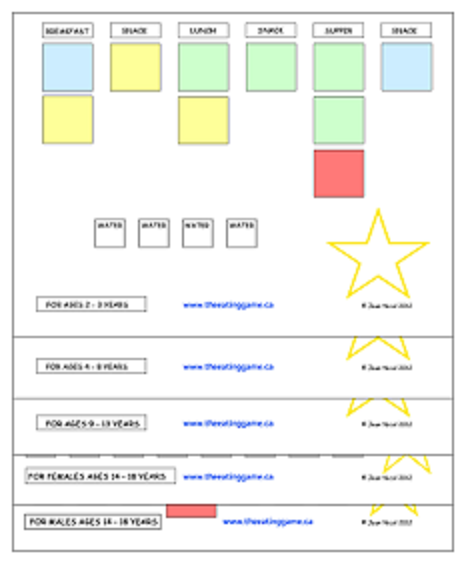
The Eating Game has 5 meal planning charts that are card stock with 5 mil laminating for:
2 - 3 years
4 - 8 years
9 - 13 years
Females 14 - 18 years
Males 14 - 18 years
NOTE: I also have adult charts available for males & females 19 - 50 and 51+. Please just ask and I will exchange charts for younger age charts that you wouldn't need.
The chart being used can be removed from the binder for easy use and be able to be displayed daily in a prominent place.
Each meal planning chart has six meals:

Breakfast
Snack
Lunch
Snack
Supper
Snack
The four colors on the chart refer to the 4 food groups:
Green - Fruit & Vegetables
Yellow - Grains
Red - Meat & Alternatives
Blue - Milk & Alternatives
The number of each color indicates the recommended number of servings for 1 day; the arrangement being the creators choice.
There are also squares to place pictures of water.
Each square has a velcro button.
There are 4 sets of food pictures, over 240 in total.

They are color coded to match the squares on the
planning charts.
Green - Fruit & Vegetables
Yellow - Grains
Red - Meat & Alternatives
Blue - Milk & Alternatives
Each picture is on 5 mil laminated card stock with a velcro button on the back so that it will adhere to the chart.
Each day you would display only the foods from the 4 groups that your child will choose from to plan their meals for the day. You would begin by presenting any foods they have eaten in their life time that you have on hand that day.
.......................................... Jean Nicol
These photos with description, explain the components of The Eating Game and how it works. It is presented in a 3 ring binder with a copy of Canada's Food Guide, very similar to guide recommendations in other countries.In creating The Eating Game I drew on my education (degree in Nutrition and Education, specializing in Special Education) and my 37 years of work experience as a Special Education Teacher, SchoolBoard Autism Consultant and Early interventionist. For more info and to order your copy go to www.theeatinggame.ca Click on each photo for further explanation. Feel free to ask questions. Modifications can be made too.

The United States granted my Patent # 8,333,593 B2 was granted on Dec 18, 2012; the Canadian Patent in January 2014.. This is a unique invention that can be used by a child to plan meals independently. No other patented invention provided a meal planner that could be used by almost any child, verbal or non verbal, gifted or challenged with delays.
To order http://theeatinggame.ca/

The Eating Game has 5 meal planning charts that are card stock with 5 mil laminating for:
2 - 3 years
4 - 8 years
9 - 13 years
Females 14 - 18 years
Males 14 - 18 years
NOTE: I also have adult charts available for males & females 19 - 50 and 51+. Please just ask and I will exchange charts for younger age charts that you wouldn't need.
The chart being used can be removed from the binder for easy use and be able to be displayed daily in a prominent place.
Each meal planning chart has six meals:

Breakfast
Snack
Lunch
Snack
Supper
Snack
The four colors on the chart refer to the 4 food groups:
Green - Fruit & Vegetables
Yellow - Grains
Red - Meat & Alternatives
Blue - Milk & Alternatives
The number of each color indicates the recommended number of servings for 1 day; the arrangement being the creators choice.
There are also squares to place pictures of water.
Each square has a velcro button.
There are 4 sets of food pictures, over 240 in total.

They are color coded to match the squares on the
planning charts.
Green - Fruit & Vegetables
Yellow - Grains
Red - Meat & Alternatives
Blue - Milk & Alternatives
Each picture is on 5 mil laminated card stock with a velcro button on the back so that it will adhere to the chart.
Each day you would display only the foods from the 4 groups that your child will choose from to plan their meals for the day. You would begin by presenting any foods they have eaten in their life time that you have on hand that day.
Choosing foods, from those presented by the parent/caregiver, the pictures are placed on the daily planning chart by matching colors to plan each meal/snack for the day. There is now a very visual plan that will make the mealtime environment very predictable. At the end of the day the pictures are removed and the next day can be planned! It is an easy structure for a child to work with and one that remains the same for a lifetime! The routine of planning everyday at the same time will be beneficial to most children and the family. Very quickly, most children will be able to do this independently.
.......................................... Jean Nicol
Tuesday, June 24, 2014
MAKING MEALS FUN
Thank you Gabrielle Kaplan-Mayer for this guest blog and for the great ideas you present for parents and kids!
www.kitchenclassroom4kids.com
In the first few
months of transitioning my family to eating gluten and casein-free, I wanted
everything to be perfect: I would scour
recipes to find the perfect gf bread, order expensive snacks online and spend
hours planning meals. What usually happened when serving those meals was that
my son, who has autism and motivated the dietary change, would take two bites
of whatever food that I had slaved over and then get up and run away from the
table. I would bring him back to his plate, cajole him to eat more, and maybe
he would take one more bite. Mealtime in our home became, in a word, miserable.
Soon I realized
that something needed to change if we were going to be able to stick with
dietary changes as part of my son’s healing process. And I was motivated to
stick with it: within a few months of eating gfcf, my son was finally sleeping
through the night and having normal bowel movements. I realized that it wasn’t
the diet that needed to change, but my attitude and approach towards it.
Over the last five
years, these are some of the ways that I’ve been able to sustain and embrace
the gfcf diet:
1.
Awareness of my attitude: I first needed
to acknowledge the amount of pressure that I was putting on myself in creating
meals and the pressure that I was bringing to my son at mealtime. I started to
take a few deep breaths before sitting down at the table. Rather than slaving
for hours making complex recipes, I started to cook simple, whole foods:
chicken breast sautéed in coconut oil, meatballs made with grassfed beef and
served over gf pasta. These meals were much more successful with my whole
family than the ones that took hours to prepare (recipes are in my book “The
Kitchen Classroom”) and I didn’t come to the table completely frazzled.
2.
Getting the Kids Involved: One of the
best ways that I’ve been able to make eating gfcf work well in my house is
involving my kids in meal preparation. What I’ve discovered is that all of the fine
and gross motor skills that my son works on in therapy can be practiced through
chopping, stirring, mixing, unpacking groceries, etc. Bringing my kids in to wash fruit for a fruit
salad or break apart the celery stalks that will be on their dinner plate makes
them both more eager to taste everything that I serve!
3.
Playing with your food: This one might
seem like a no-no, but I like to find ways to play that are good for everyone.
To encourage my kids to eat a wider variety of fruits and vegetables, I started
picking a letter of the week and buying
produce to match the letter. Although my son is just now learning to read,
working on the letter recognition was an important part of developing his pre-literacy
skills. I’ve made my 45 alphabetical recipes into an ebook called ABC Fruits & Veggies 4 Me!
4.
Setting the mood: As busy parents,
sometimes our goal is simply to get through our meals with everyone intact.
When I’m able to take that extra moment before we sit down, I put on some
mellow music to listen to while we eat and this also helps to shift everyone’s
mood. My son takes longer to eat than my
daughter does but what we’ve worked out is that she can choose a few books to bring
to the table when she finishes. This helps her to enjoy staying at the table
with us. Think about what simple elements like music and books that could help
to make your meals more pleasant.
5.
Remember 2 words—“Not Yet”: I often
coach parents who lament that their children will not try new foods, especially
fruits, vegetables and protein and have trouble sitting for meals. My answer is
always “Not Yet”—but with patience, persistence and some creative
strategies, here is hope that your child
will begin to eat a wider variety of foods and that meals in your home will
become important family connecting time. Please don’t hesitate to send me your
questions or concerns—I’m happy to brainstorm: gabrielle@kitchenclassroom4kids.com.
Gabrielle
Kaplan-Mayer is a writer, cooking instructor and parenting coach. Visit her at
www.kitchenclassroom4kids.com
Tuesday, June 3, 2014
An Eating Game Question and a Gift
This week a mom wrote to us, “I recently pulled out The Eating Game I had ordered years ago. If you are having cereal and milk, for example, do you use a cereal for the carb and a milk for the dairy? Another example would be a taco – I noticed it is in two categories. Thank you. My 14-yr old is very excited to start an eating structure!”
My response was, “I understand your question and debated that issue when I created it. I decided to go this way to make it easier for children to use it independently. So for them the background color is significant. For some they may want on their own to count the cereal and milk as both and I’d agree with that. I thought of pizza having all 4 food groups, actually when homemade could be a healthy meal in itself if there are lots of veggies! In the end the choice is up to you I guess. There are no hard and fast rules.
The key to using The Eating Game is to adapt it to work best for you, letting the basic structure and daily use have the planner making more varied and healthier choices. The visual supports make it easy for anyone to use, supporting those with communication challenges. Letting the user be in control of the choices and creating a predictable eating environment is of course a major plus.
Especially with kids who are over eaters it would be key to focus on appropriate serving sizes.”
I am in the process of creating new food pictures that are photos of foods which will clear up the cereal/milk type of question. We will be offering a special GIFT, a set of food photos to families using The Eating Game who send us their story and photo with The Eating Game. Contact us at jean@theeatinggame.ca for more info about this gift.
Thursday, May 1, 2014
SHOULD THIS BE A WORRY OR NOT?
It is reported that about 75% of the children on the autism spectrum have eating challenges and there is no shortage of literature, therapies and advice on what might help.
As a parent with a child who is not eating a healthy diet you worry. As with any child who has eating issues preventing healthy diet you need to investigate the "why" even if the advice you get is "don't worry/they will be fine/it's a phase/they will grow out of it/they will eat enough so as to not be hungry...... etc, etc"
With 30 years experience with autism and having a nutrition background I need to tell you that you do need to be concerned. Every child needs a healthy diet to promote healthy growth and to provide the nutrition they need to perform and achieve their personal best in play, school work, sports, music, art, sleep, behavior, social interaction, emotional growth, independence ~ LIFE! ~ all the things you hope for for your child. Autism itself may well play a major role and often alongside other issues. All need to be investigated.

If your child is not able to eat foods ~ chew, swallow, digest ~ start by making sure there is nothing physically wrong. Some children have needed surgical treatment that has been the solution to allow them to enjoy a healthy diet.
Next, if you suspect there may be some food allergies ask your pediatrician for a referral for allergy testing to confirm or rule out your suspicions.
If you know or suspect your child has sensory processing issues then they need to be addressed. I can recommend a good starting point http://www.sensory-processing-disorder.com/sensory-processing-disorder-checklist.html and consulting with an Occupational Therapist who specializes in SPD would be very beneficial.
You may now have to consider that although your child does not have allergies perhaps they have sensitivities or intolerances to certain foods. They may even be favorite foods! You can check this yourself by eliminating some foods to see if there are obvious benefits. This is an area where many parents of autistic children find some answers - specifically with gluten and casein.
I personally have experience with eliminating gluten from my diet and seeing significant health benefits in 3 weeks. It has been 3 months since I removed gluten from my diet and I won't be eating it anymore. It is certainly worth a try. I would say the same for casein, which will mean you eliminate all products made with cows milk.
This would appear to be a good resource to begin learning more about these dietary needs http://www.gfcfdiet.com/.
Whatever you find to be the problem, if there are still issues preventing your child from choosing to eat a wide variety of healthy foods then I would strongly recommend you investigate how The Eating Game can help. It will support any special diet you use as it is you, the parent, who presents the food choices for your child to use with The Eating Game. You can contact me at jean@theeatinggame.ca if you want more information.
If you have anything to share that may help another person, please consider leaving a comment.
As a parent with a child who is not eating a healthy diet you worry. As with any child who has eating issues preventing healthy diet you need to investigate the "why" even if the advice you get is "don't worry/they will be fine/it's a phase/they will grow out of it/they will eat enough so as to not be hungry...... etc, etc"
With 30 years experience with autism and having a nutrition background I need to tell you that you do need to be concerned. Every child needs a healthy diet to promote healthy growth and to provide the nutrition they need to perform and achieve their personal best in play, school work, sports, music, art, sleep, behavior, social interaction, emotional growth, independence ~ LIFE! ~ all the things you hope for for your child. Autism itself may well play a major role and often alongside other issues. All need to be investigated.

If your child is not able to eat foods ~ chew, swallow, digest ~ start by making sure there is nothing physically wrong. Some children have needed surgical treatment that has been the solution to allow them to enjoy a healthy diet.
Next, if you suspect there may be some food allergies ask your pediatrician for a referral for allergy testing to confirm or rule out your suspicions.
If you know or suspect your child has sensory processing issues then they need to be addressed. I can recommend a good starting point http://www.sensory-processing-disorder.com/sensory-processing-disorder-checklist.html and consulting with an Occupational Therapist who specializes in SPD would be very beneficial.
You may now have to consider that although your child does not have allergies perhaps they have sensitivities or intolerances to certain foods. They may even be favorite foods! You can check this yourself by eliminating some foods to see if there are obvious benefits. This is an area where many parents of autistic children find some answers - specifically with gluten and casein.
I personally have experience with eliminating gluten from my diet and seeing significant health benefits in 3 weeks. It has been 3 months since I removed gluten from my diet and I won't be eating it anymore. It is certainly worth a try. I would say the same for casein, which will mean you eliminate all products made with cows milk.
This would appear to be a good resource to begin learning more about these dietary needs http://www.gfcfdiet.com/.
Whatever you find to be the problem, if there are still issues preventing your child from choosing to eat a wide variety of healthy foods then I would strongly recommend you investigate how The Eating Game can help. It will support any special diet you use as it is you, the parent, who presents the food choices for your child to use with The Eating Game. You can contact me at jean@theeatinggame.ca if you want more information.
If you have anything to share that may help another person, please consider leaving a comment.
Wednesday, April 9, 2014
THE EATING GAME LINE OF PRODUCTS
Since 2007 many Eating Game products have been developed:
1) the original Eating Game, in a 3 ring binder, ready to use is available in English, French and Mi’kmaq
1) the original Eating Game, in a 3 ring binder, ready to use is available in English, French and Mi’kmaq
2) the MIY (Make It Yourself) Kit in English, French and Mi’kmaq
3) the Digital Downloadable Edition, available in English and French
4) the Eater’s Choice Daily Meal Planner offers the user the same convenient reusable meal planner without the pictures; available in English for ages 4 - 51+
5) the Digital format of The Eater’s Choice Daily Meal Planner
The Eating Game now has Patent Rights ~
US Patent #8,333,593 B2 granted in Dec 2013
Canadian Patent # 2,612,218 granted in Jan 2014
To learn more and order the edition that is best for your family go to www.theeatinggame.ca For further information contact us via email from this website
To learn more and order the edition that is best for your family go to www.theeatinggame.ca For further information contact us via email from this website
Tuesday, April 1, 2014
THE EATING GAME NEWSLETTER APRIL GIVEAWAY
In January 2014 The Eating Game Newsletter began a year of newsletters with a GIVEAWAY every month. In January it was a Success Box www.firstandthen.com . In February it was a series of 5 Video Modeling DVDs http://www.watchmelearn.com/. In March it was a set of 8 publications from accomplished autism author Mari Nosal http://amzn.to/1dqyYcR.
To be entered for all of the 2014 draws just go to www.theeatinggame.ca and sign up for our monthly newsletter.
This month, April 2014 we are very pleased to announce that Easy Daysies will offer a wonderful Giveaway, actually two giveaways to be drawn on April 30, 2014! Thanks to Elaine Comeau for this generous contribution and the following guest blog.
The Award Winning Easy Daysies® Daily Schedules help show kids the “shape of the day”. Use these fun magnets for a single routine, like bed time or after school routine, or plan the whole day! This mom/teacher-created product, made with 70% recycled materials, help children become more co-operative, independent, & less anxious because they feel safe & confident knowing what is happening next! Wonderful for helping kids of any age, and children with special needs, deal with event transitions and anxiety. Easy Daysies is recommended by name by child psychologists and occupational therapists.
Easy Daysies was created off the kitchen table by parent demand to help their kids at home become more independent, less anxious and more co-operative, making the day easier for all in the family. That is how it got its name, Easy Daysies®! Easy Daysies continues to win multiple awards including: 2014 Teacher Trendsetter Product Award, Mom's Choice Award, 2013 Teachers' Choice Award for Families, 2012 Educational Product of the Year by Creative Child Magazine, Dr. Toy's Top 10 Socially Responsible Toys, and the Parent Tested Parent Approved Award.
Easy Daysies was created off the kitchen table by parent demand to help their kids at home become more independent, less anxious and more co-operative, making the day easier for all in the family. That is how it got its name, Easy Daysies®! Easy Daysies continues to win multiple awards including: 2014 Teacher Trendsetter Product Award, Mom's Choice Award, 2013 Teachers' Choice Award for Families, 2012 Educational Product of the Year by Creative Child Magazine, Dr. Toy's Top 10 Socially Responsible Toys, and the Parent Tested Parent Approved Award.
3. Show your child the first step needed to be done. Help them accomplish it and then have them move the magnet to the "Done" column. This movement of the magnet allows them to feel rewarded, like getting a pat on the back. We want to help our children learn this life skill, that there are things to be done in a day and getting it done is the reward in itself!
Have fun with your family and we wish you many easy daysies days!
LET YOUR LIGHT SHINE ON AUTISM
Whether you turn on a special light bulb, display an autism ribbon with
multi colored puzzle pieces or display a colorful rainbow use these symbols
to increase awareness, understanding and acceptance of those on the
autism spectrum.
The spectrum of colors represents the spectrum of talents, abilities and beauty of now 1 in 68 children in North America.
Many activities promoted by caring individuals, families, community organizations and support groups will take place over the course of the month. Tomorrow April 2, 2014 is World Autism Awareness Day.
However you celebrate on April 2nd and throughout the month, LET YOUR LIGHT SHINE on autism to increase awareness, understanding and acceptance of autism in your family, among friends and in the community - local and global!
I will light it up GOLD on April 2, 2014 with International Naturally Autistic People Awards, Convention and Festival and invite you to join their facebook event at 2pm PDT https://www.facebook.com/events/642461785793149/

Friday, March 28, 2014
A CHALLENGE FOR US ALL
The faces of autism are all different and present many different challenges in the areas of communication, cognition, social skills, social interaction, repetitive behaviors, dietary/digestive disorders and sensory processing. These challenges differ in intensity/severity in each individual diagnosed with ASD and can affect many areas of development and daily living.
At this time, although research continues and reports new findings, we do not know the causes and therefore have no cure or effective treatment/intervention for all. Parents and advocates lobby everywhere and constantly for an increase in research to find answers for this disorder that affects so many. A major challenge with this effort is to try to get advocates speaking in a united voice when some feel they are fighting very different battles and not being heard. Just the question of "cure" divides the autism community itself, never mind the vast variety of treatment offerings. The latter being a need based on the spectrum of strengths and needs as well as the severity of the autism.
There are some very good therapies and strategies that can definitely make a difference. We know that early and intensive intervention for all areas of need is crucial and very beneficial. The added challenge is always funding for what is usually a great expense.
Today we read in the news that Canadian and American studies are reporting a 30% increase from the last estimate of 1 in 88 children having autism - today the numbers are 1 in 68!
If autism is affecting 1 in 68 families soon everyone will have first hand experience of autism among family and friends. My sense is that by sheer numbers we have increased awareness but still have a long way to go with improving on understanding and acceptance. Everyone can help. If you are aware, share what you know with others. If you are not aware ask and seek out ways to learn more about this disorder that could easily affect your extended family at any time soon.
On April 2, 2014 the world will celebrate World Autism Day. Some will light it up blue, others red and some gold! Whatever color you choose or not, shine a light on autism to do your part to help many with the tremendous daily challenges they face to provide the best for those they love who are autistic.
MY CHALLENGE FOR YOU is to contribute a comment here, asking questions to increase awareness or sharing an experience/thoughts/resources that will help others learn about ASD.
At this time, although research continues and reports new findings, we do not know the causes and therefore have no cure or effective treatment/intervention for all. Parents and advocates lobby everywhere and constantly for an increase in research to find answers for this disorder that affects so many. A major challenge with this effort is to try to get advocates speaking in a united voice when some feel they are fighting very different battles and not being heard. Just the question of "cure" divides the autism community itself, never mind the vast variety of treatment offerings. The latter being a need based on the spectrum of strengths and needs as well as the severity of the autism.
There are some very good therapies and strategies that can definitely make a difference. We know that early and intensive intervention for all areas of need is crucial and very beneficial. The added challenge is always funding for what is usually a great expense.
Today we read in the news that Canadian and American studies are reporting a 30% increase from the last estimate of 1 in 88 children having autism - today the numbers are 1 in 68!
If autism is affecting 1 in 68 families soon everyone will have first hand experience of autism among family and friends. My sense is that by sheer numbers we have increased awareness but still have a long way to go with improving on understanding and acceptance. Everyone can help. If you are aware, share what you know with others. If you are not aware ask and seek out ways to learn more about this disorder that could easily affect your extended family at any time soon.
On April 2, 2014 the world will celebrate World Autism Day. Some will light it up blue, others red and some gold! Whatever color you choose or not, shine a light on autism to do your part to help many with the tremendous daily challenges they face to provide the best for those they love who are autistic.
MY CHALLENGE FOR YOU is to contribute a comment here, asking questions to increase awareness or sharing an experience/thoughts/resources that will help others learn about ASD.
Labels:
1 in 68,
2014,
acceptance,
April 2,
ASD,
autism,
awareness,
challenges,
intervention,
treatment,
understanding
Saturday, March 22, 2014
ASPERGERS
by Mari Nosal, M.Ed., CECE
As a seasoned parent of a son with Asperger’s, and please note I have a son with Asperger’s, not an Aspie son. I define him as a young man not Asperger’s. You will also note that I do not refer to Asperger’s as a disorder. I refer to it as a syndrome. A disorder alludes to something or someone who is broken and needs to be fixed. i.e. a computer virus that can be repaired. A syndrome is a challenge that one must adapt to and live with. Compensatory strategies may be taught to ensure a level of success. But Asperger’s can’t be fixed.
I have most definitely experienced a multitude of emotions in terms of parenting my son to young adulthood, and still do.. If I named every emotion I have felt, they would most likely have a length span which would originate on earth and reach as high as the furthest star in space.
To name several, I have experienced apprehension which was resultant in my fear for my son’s future. I felt pain from the inevitable ostracism he endured at the hands of peers, and adults. I have experienced sadness which originated from my sons struggles and not conforming to my perception of who he was intended to be, the person I visualized he would become, and the things I felt he should think and feel.
I have felt the uncertainty resulting from naysayer’s comments and predictions of who my son would become as a person both developmentally and behavioral. Naysayers predicted how my son would develop and what his future achievements or lack thereof. One would think professionals and society at large had psychic abilities and peered into a crystal ball to make predictions.
To parents with newly diagnosed children, I am here to emphatically implore you never to give up hope. If you give up hope, your children will certainly give up as well. You will get frustrated, feel the uncontrollable urge to bang your head on a wall, cry, and yes at times even wonder why you were blessed with a child with Asperger’s. You may even, (horrors) wish that your child would go away.
You may find yourself feeling intense pangs of jealousy when you see your child’s schoolmates walk by in a clique laughing away as they enjoy their day of play together. You may even experience intense anger and jealousy towards other parents while you silently wonder why their child was not born with challenges.
These feelings are all normal. Parents are human beings. Wishing your child would go away while you are under duress does not mean you really want him to disappear. On the contrary – it means you have invested so much love and expended so much effort into doing what is best for your child, that you merely crossed the line from loving them to the point exhaustion.
If you are the parent of a younger child, please do not surround yourselves with, nor listen to the naysayers who predict a life of doom, gloom, and anguish for your child. After all, you know your child better than anyone. You live with them 24-7. Trust your instincts. A parent knows what is best for their child. You are your child’s best advocate. Your child will take two steps backward for everyone they take forward. Adjust your expectations. Do not be hard on yourself and note merely the steps backwards. I f you adjust your expectations and look hard enough for the small steps forward you will be surprised at the growth that was not seen.
Children with Asperger’s do develop and succeed within the right environment. The anxiety stems from basing our expectations on what the Jones’s kids down the street are doing, what our friends and neighbors think of our children and us as parents. If we let go of those expectations and gauge successes on our child’s developmental and cognitive level and not other children their age, we will be pleasantly surprised.
Note your child’s achievement’s in baby steps. Do not worry about what your child will achieve ten years down the line. i.e. will they have a girlfriend, kids, get married, have friends, or simply get a decent job that will enable them to live independently. Remember that the average child with Asperger’s has a developmental age that lags 4 years behind their chronological age.
As the parent of a young adult son with Asperger’s I am hear to tell you that they have many attributes to appreciate. On a humorous note I will start with my son’s knowledge of electronics and computers. This sense of awe I now have for his computer talents were a sense of frustration when he was young. I cannot count how many computers he corrupted and how many mother boards he damaged while dismantling our computers, rebuilding them, and programming them with incompatible hardware.
As a little boy with Asperger’s, my son imitated people with foreign accents in public places. His lack of discretion would cause me to become flush from embarrassment. His knack for impersonations has come in handy when telemarketers call. My son convinces them that he is from a foreign country and doesn’t understand English. The telemarketers inadvertently hang up. I will emphasize that he has learned the fine art of discretion and outgrow public renditions of impersonations.
That young man has grown up to be a computer whiz and can now install modems, set up our new computers, and install programs safely. His talents have saved us a princely some of money for cable personnel, phone personnel, and computer repairman that did not warrant calling due to his self-taught expertise. My fondest memory was when the cable company wanted to come out and set up our new digital cable box. My son offered to do it for free. My digital system was set up in all of 12 minutes. My son was the ripe old age of twelve at the time!!!!!!!!!!!!!!!!!! Thus, what was deemed a negative and aggravating personality trait as a child has proved to be an attribute as a young adult.
As a young child my son was prone to emotional meltdowns from sensory overload. As a teenager he would provide a verbal debate for any topic or request directed towards him. If I sent him to his room for being argumentative, his debate often continued in a solitary dialogue as a soliloquy. His strong personality allowed him to walk away from children who were doing drugs, etc. Yes, a sense of nonconformity can have its merits. His debate skills turned into a talent for writing.
A humorous example from his childhood would be when we attempted to use the magic 1, 2, 3, program to teach appropriate behavior skills. Our son would act inappropriately and we would put up 1, 2, 3, fingers. When he continued to voice his opinion we sent him to his bedroom. After several weeks of implementing the behavioral program we realized that he would act up ,hence get sent to his room right before we were due to leave for church. We realized he goaded us into implementing the 1, 2, 3, program so he would not have to go to church. We quickly modified that and informed him that he would be expected to go to his room AFTER church. My son walked away and yelled, “That magic one, two, three doctor is a quack” :-0)
I am proud to say that by injecting a little humor, perseverance, venting occasionally to anyone that would listen, and most importantly adjusting our expectations to my sons needs he recently received his bachelor’s degree in psychology from college with a struggle, but much perseverance on his and our part. He successfully lived in the dorm. Again he struggled, but we were 45 minutes away if he needed us but wanted to give him a taste of independence. Independence that did not include the normal socialization of college life by neurotypical standards. But being with peers and fending for himself nonetheless. As I mentioned earlier, process and accept it in baby steps.
My son has a driver’s license. He passed after three failed attempts, but along with us he persevered and never gave up. Make no mistake our family still struggles, worries, and gets frustrated just like other parents. But as time has passed we have learned not only the art of teaching our son to accommodate us but to realize we need to accommodate him as well. I equate our quest with accepting my son. If we expect him to learn societal mores of the neurotypicals than we must attempt to make adjustments for him as well.
When in a foreign country Americans tend to expect foreigners to speak English so we can comprehend them. Shouldn’t we make the same accommodations for individuals with Asperger’s as well? They speak a different language than neurotypicals hence they can learn the world of neurotypicals but we can learn about the Aspergian lifestyle as well.
Parents, I leave you with this. If you have not pulled so much hair out of your head that you are now bald from frustration at this point I salute you. Yes, it does get better:-0)
Rock on, give your selves a pat on the back for a job well done as parents, and know there is light at the end of the tunnel.
Subscribe to:
Posts (Atom)





























